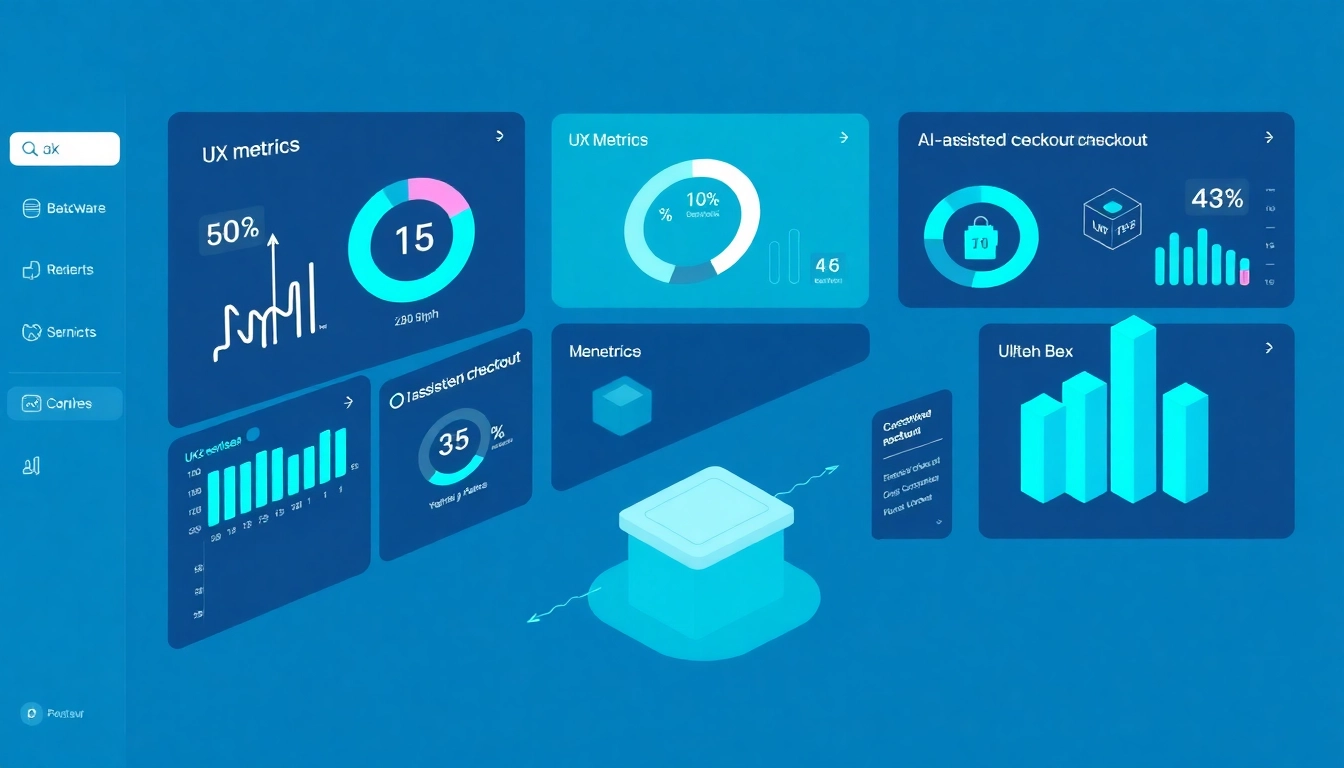In the digital economy, technology is the invisible engine driving user experiences, operational efficiency, and strategic decision-making. For ecommerce teams, the right tech choices translate into smoother checkout flows, higher conversion rates, and better post-purchase engagement. This article presents a practical, evidence-based roadmap that integrates UX principles, AI deployment considerations, and market strategy to deliver measurable business outcomes across industries.
From foundational UX improvements in checkout to AI-enabled operations, the conversation centers on how technology can be harnessed effectively. To explore a centralized hub of technology insights and practical guidance, visit our Techdee resource on technology.
Foundations of Technology for Modern E-commerce UX
Technology basics for user-centered checkout
At the core of any successful ecommerce experience is a checkout that feels effortless, trustworthy, and fast. The technology foundations here include front-end performance, secure data handling, and streamlined interaction design. Start with optimization of core web vitals—loading, interactivity, and visual stability (commonly known as LCP, FID, and CLS). A sluggish checkout increases abandonment risk regardless of product appeal, so first-in-class stores invest in a performance budget that prioritizes critical path rendering, asynchronous loading of non-essential assets, and minimized payloads for mobile devices.
Beyond speed, form ergonomics and intelligent defaults reduce cognitive load. Techniques such as inline validation, auto-fill, and masked inputs accelerate completion while maintaining data integrity. Progressive disclosure—displaying essential fields up front and deferring optional information—helps maintain momentum, particularly on mobile where screen real estate is precious. Security-focused UX, including visible reassurance (e.g., trusted payment badges, clear error messages, and a transparent privacy policy) builds confidence without interrupting flow.
Checkout orchestration platforms are a category of technology that centralizes payment routing, tax calculations, and shipping rules. They enable businesses to present localized options without reengineering the entire checkout every time a new market is entered. For teams pursuing global expansion, it’s essential to adopt a modular architecture that supports multi-currency handling, localized formats, and fraud prevention without compromising performance.
Implementation steps:
- Audit page performance specifically on the checkout path; set a target LCP under 2.5 seconds on 3G/4G networks.
- Standardize input experiences with universal patterns (address autofill, country pickers, and payment method discovery).
- Adopt a secure-by-default approach: PCI-DSS alignment, tokenization of payment data, and ongoing risk monitoring.
- Prototype checkout variants (A/B tests) to quantify impact on conversion and average order value (AOV).
Case in point: a mid-market retailer shaved cart abandonment by 18% after adopting a single, optimized checkout flow with real-time form validation, progressive disclosure of optional fields, and trusted payment endorsements integrated into the UI. The result was a lift in completed purchases without sacrificing security or data quality.
Technology metrics for UX success
Measuring UX success requires a blend of product analytics, usability metrics, and business outcomes. The most actionable metrics fall into three categories: usability, performance, and business impact. Usability metrics include task success rate, time on task, and error rate during checkout. Performance metrics focus on page speed, responsiveness, and perceived performance signals such as on-page loading indicators and skeleton UIs. Business metrics connect UX changes to revenue and loyalty outcomes—conversion rate, checkout completion rate, and post-purchase engagement indicators.
To operationalize these metrics, create a UX scorecard anchored by a quarterly baseline plus monthly improvement targets. For example, you might target a 5–7% uplift in checkout completion within six weeks of deploying a redesigned input experience and a 10% reduction in form errors following improved validation guidance. A/B testing is essential to isolate the impact of specific changes; ensure statistically significant results before scaling.
Qualitative feedback remains valuable. Short, structured usability sessions with a diverse user group can uncover exit points and confusion that raw numbers miss. Combine feedback with analytics to identify friction clusters—regions of the checkout funnel where drop-offs concentrate—and prioritize fixes with the greatest potential ROI.
Performance dashboards should be accessible to cross-functional teams. A lightweight, real-time dashboard indicating LCP, Total Blocking Time (TBT), and First Input Delay (FID) alongside conversion metrics helps product managers, designers, and engineers align on priorities and timelines. A strong UX program blends data-driven insights with iterative design, ensuring that each iteration is responsible, measurable, and scalable.
Technology considerations for accessibility and security
Accessibility is a prerequisite for modern UX—the experience should be perceivable, operable, understandable, and robust for all users, including those with disabilities. Accessibility considerations in checkout include keyboard navigability, screen reader compatibility, sufficient color contrast, properly labeled form fields, and predictable focus management. Implement an accessibility (A11y) baseline early in the design process and verify compliance with WCAG 2.1 AA standards. In practice, this involves semantic HTML, ARIA roles where appropriate, and perceptible cues for dynamic content changes.
Security is inseparable from trust in ecommerce. Beyond encryption and PCI-DSS compliance, UX must communicate security without creating friction. This means transparent authentication flows, visible indicators of secure connections, and clear guidance when errors occur. Consider risk-based authentication that adapts friction to context—low-risk sessions might skip multi-factor prompts, while high-risk interactions prompt stronger verification. Regular security testing, including client-side checks and server-side validation, reduces the likelihood of XSS, CSRF, and payment tampering while preserving a smooth user journey.
Balancing accessibility, security, and friction is nuanced. For example, adding two-factor authentication (2FA) can improve security but may impede conversion if not implemented thoughtfully. Techniques to mitigate this include offering a familiar 2FA method (e.g., authenticator apps), enabling trusted devices, and offering a secure one-tap backup method. In the end, the optimal approach aligns with user expectations, risk profile, and brand commitments, delivering a checkout experience that feels both safe and effortless.
AI Deployment and Technology in Business Operations
Integrating technology into AI-driven workflows
AI deployments reshape how teams operate, making workflows more data-driven, scalable, and responsive. The first step is to map business processes that can benefit from AI augmentation—customer service, demand forecasting, content personalization, supply chain optimization, and fraud detection are common starting points. The integration blueprint involves data readiness, model selection, and orchestration across the tech stack. Data quality is foundational: clean, labeled, and accessible data enable AI to deliver reliable predictions and prescriptive guidance.
A practical approach is to implement AI in modular stages. Start with a pilot in a high-value area, such as predictive merchandising or dynamic pricing, and establish a governance model that includes data ownership, model performance metrics, and incident response processes. As AI models mature, expand to cross-functional uses, ensuring the orchestration layer (an integration bus or orchestration platform) connects data sources, analytics, and action triggers (e.g., automatic product recommendations, inventory reallocations, or chat-based customer support flows).
Operationalizing AI requires strong collaboration between data scientists, engineers, product managers, and UX designers. Cross-functional squads should own end-to-end outcomes, with clear success criteria, governance protocols, and feedback loops that translate model outputs into user-visible features or operational changes.
Risk management and governance in technology deployments
As organizations deploy AI and automation, governance becomes a strategic capability. A robust governance framework addresses data privacy, bias mitigation, compliance, model risk, and change management. Key components include a risk register for AI initiatives, model documentation (data lineage, training data, evaluation metrics), and an auditable decision trail that documents how AI outputs influence business actions. Governance also covers vendor risk and third-party data inputs, ensuring that external data sources meet quality and security standards.
Practical steps include establishing an AI ethics and governance council, implementing bias detection and monitoring tools, and conducting regular model drift assessments. Create playbooks for model updates, rollback procedures, and controlled experimentation. Transparency with stakeholders—internal teams, regulators, and customers—helps set expectations and maintain trust as AI capabilities evolve.
Cost-benefit steps for adopting technology in operations
Technology investments in operations should be justified with clear cost-benefit analyses that account for both tangible and intangible returns. Begin with a current-state assessment: identify pain points, quantify the cost of inefficiencies, and estimate potential improvements in throughput or accuracy. Build a business case that includes upfront costs (software licenses, integrations, data engineering), ongoing expenses (maintenance, monitoring, security), and expected benefits (time savings, error reduction, revenue lift).
Adopt a phased optimization plan with measurable milestones. Typical milestones might include a 20–30% reduction in manual data handling time within three quarters, a 10–15% uplift in forecast accuracy, and a 5–10% improvement in customer satisfaction due to faster, more accurate service. Use pilot programs to validate ROI before wide-scale deployment. Finally, institutionalize continuous improvement by monitoring key performance indicators (KPIs) and scheduling regular optimization sprints based on data-driven insights.
Technology-Driven Customer Interactions
Personalization using technology-enabled frameworks
Personalization has moved beyond “recommendations” to engineered experiences tailored to intent, purchase history, and cross-channel behavior. Technology-enabled frameworks combine customer data platforms (CDPs), analytics, and experimentation to drive relevance at every touchpoint. A modern personalization stack captures first-party data (site behavior, preferences, and prior purchases) and uses predictive models to surface content, offers, and messages that align with a shopper’s stage in the journey. Importantly, personalization should be contextual and privacy-respecting, with clear consent management and transparent value exchange.
Examples include adaptive product discovery journeys that rearrange category navigation based on intent signals, real-time price and shipping ETA personalization, and post-purchase follow-ups that propose complementary items or accessories. Implement governance to avoid over-personalization that can feel intrusive; keep a human-in-the-loop option for critical decisions and provide straightforward ways for customers to adjust their preferences.
Best practices:
- Start with a few highest-impact personalization scenarios and measure incremental lift in conversion or AOV.
- Ensure data quality and consent across channels to avoid inconsistent experiences.
- Use test-and-learn to refine algorithms, ensuring changes are customer-centric and aligned with brand voice.
Omnichannel experiences powered by technology
Omnichannel experiences are united through a single view of the customer, synchronized across devices and channels. The technology stack includes data integration platforms, CRM, marketing automation, and real-time event streams that enable consistent messaging, inventory visibility, and service continuity. A seamless omnichannel experience means a shopper can start a purchase on mobile, receive tailored guidance in chat, and complete checkout on desktop without re-entering data or losing context.
Key enablers include real-time inventory synchronization, unified customer profiles, cross-channel attribution models, and consistent design systems across touchpoints. Operational readiness also matters: support teams must have access to a complete customer view, enabling proactive assistance and timely interventions, such as notifying a customer of a delayed shipment with an option to switch to faster shipping or to re-route to a local pickup point.
KPIs for technology-driven customer engagement
When measuring the impact of technology-enabled customer interactions, focus on a balanced scorecard that covers engagement, satisfaction, and business outcomes. Potential KPIs include:
- Engagement: time-in-session, interaction depth, and touchpoint reach across channels.
- Satisfaction: CSAT, NPS, and customer effort score (CES) associated with digital interactions.
- Conversion impact: incremental revenue from personalization, uplift in cart recovery rates, and error rate reductions in self-service channels.
- Operational efficiency: average handling time for support cases, first-contact resolution rate, and automation-driven cost savings.
Establish baseline metrics, run controlled experiments, and track the long-tail effects of technology-driven interactions. Avoid vanity metrics; prioritize indicators that directly tie into customer experience and revenue growth. Regular cross-functional reviews ensure insights translate into meaningful product or service improvements.
Technology-Driven STP in Practice
Segmenting with technology-enabled data insights
Segmentation remains a cornerstone of effective market targeting. Technology enhances segmentation by enabling data-rich, dynamic segments based on behavioral signals, preference data, and real-time context. A modern approach blends demographic data with psychographic and transactional signals to define micro-segments that respond to tailored messages and offers. The outcome is more precise targeting, optimized resource allocation, and higher ROI on marketing spend.
Practical steps include building a data lake with clean, governed data from CRM, ecommerce platform, and engagement channels; establishing robust customer identifiers for cross-device tracking; and creating machine-learning models that continuously update segment definitions based on new data. It’s important to monitor data quality and ensure that segmentation logic remains aligned with business goals, avoiding overfitting to short-term trends that may erode long-term brand positioning.
Implementation blueprint:
- Define core segments anchored in business outcomes (e.g., high-LTV customers, at-risk churn segments, high-intent shoppers).
- Use propensity models to forecast conversion likelihood and content relevance.
- Automate segment-specific messaging and offers through a rules-based engine backed by real-time data streams.
Positioning strategies leveraging technology differentiators
In a crowded market, technology-driven differentiators can create meaningful competitive gaps. Positioning strategies may include emphasizing superior UX performance (fast checkout, accessible design), advanced personalization, AI-assisted customer support, and transparent governance around data use and privacy. The key is to articulate how technology translates into tangible customer benefits—faster decisions, fewer errors, and richer, more relevant experiences—while maintaining a consistent brand voice across channels.
Practical actions:
- Highlight performance milestones (e.g., median checkout time reductions, accessibility compliance achievements) in marketing materials and product narratives.
- Showcase AI-driven capabilities (e.g., predictive recommendations, proactive order updates) with customer-centric use cases.
- Publish governance commitments (data handling, bias mitigation, security practices) to build trust with privacy-conscious audiences.
Measuring STP impact with technology analytics
The effectiveness of STP (Segmentation, Targeting, Positioning) initiatives is best judged through analytics that connect audience definitions to outcomes. Core measurement areas include segment reach, conversion lift per segment, and the efficiency of message delivery. Use controlled experiments to test segment-specific campaigns against global baselines, and track the incremental value of refined targeting on customer lifetime value (CLV) and retention rates.
Analytic techniques include uplift modeling to estimate the true incremental effect of targeting, along with attribution modeling to understand how technology-driven interactions contribute to conversions across channels. Regular reviews should feed back into segment redefinition, messaging optimization, and the refinement of positioning claims to reflect evolving customer needs and competitive dynamics.
Contemporary Design and Development: Technology at the Core
Design systems and accessibility through technology
A robust design system creates consistency, accelerates development, and improves accessibility by codifying components, patterns, and interaction rules. When supplemented with accessibility-driven tooling, design systems ensure that components remain usable by diverse audiences—from keyboard-only navigators to screen reader users. Techniques include semantic HTML, accessible color palettes, scalable typography, and inclusive media strategies (captions, audio descriptions, and transcripts).
Technology enables designers to audit and enforce accessibility automatically through component libraries, automated contrast checks, and continuous integration checks that verify ARIA labeling and keyboard navigation. The result is faster iteration cycles that do not compromise accessibility or brand cohesion. Modern design systems also embrace responsive and adaptive patterns, ensuring consistent experiences across devices and contexts, which is essential for omnichannel success.
Multi-language coding and technology implications
Multi-language coding (programming languages, localization, and internationalization) is increasingly essential for teams building global-ready products. The technology implications span code maintainability, performance, and quality assurance in multilingual ecosystems. Key considerations include internationalization readiness (i18n) for content, date/time formats, currency handling, and right-to-left language support. On the engineering side, adopting language-agnostic architectures (e.g., microservices or API-driven platforms) can reduce churn when expanding to new markets or languages.
Best practices include designing for localization from the outset, using robust i18n libraries, and maintaining a centralized glossary and translation workflow to ensure consistency. Automated testing should cover locale-specific rendering, pluralization rules, and cultural relevance. Teams that integrate multi-language capabilities early in the product lifecycle avoid costly rework later and deliver experiences that resonate across geographies.
Case studies: technology-led design outcomes
Case Study A: A retailer redesigned its product discovery and checkout flow with a modular design system, leading to a 22% uplift in conversion and a 12% reduction in support queries related to form errors. The system enabled rapid experimentation across layouts, typography, and color schemes while maintaining accessibility benchmarks and a unified brand identity.
Case Study B: A construction-focused SaaS company implemented multilingual interfaces and localization-ready content for its global user base. By standardizing translation workflows and ensuring locale-aware data formatting, the company reduced onboarding time for new markets and increased trial-to-paid conversion rates by 15% in primary target regions.
Case Study C: An ecommerce platform adopted an i18n-ready microservice architecture, enabling independent teams to deploy regional features with minimal cross-team coordination. This architecture improved deployment velocity, reduced rollback risk, and supported a broader global footprint with consistent performance across languages and geographies.









